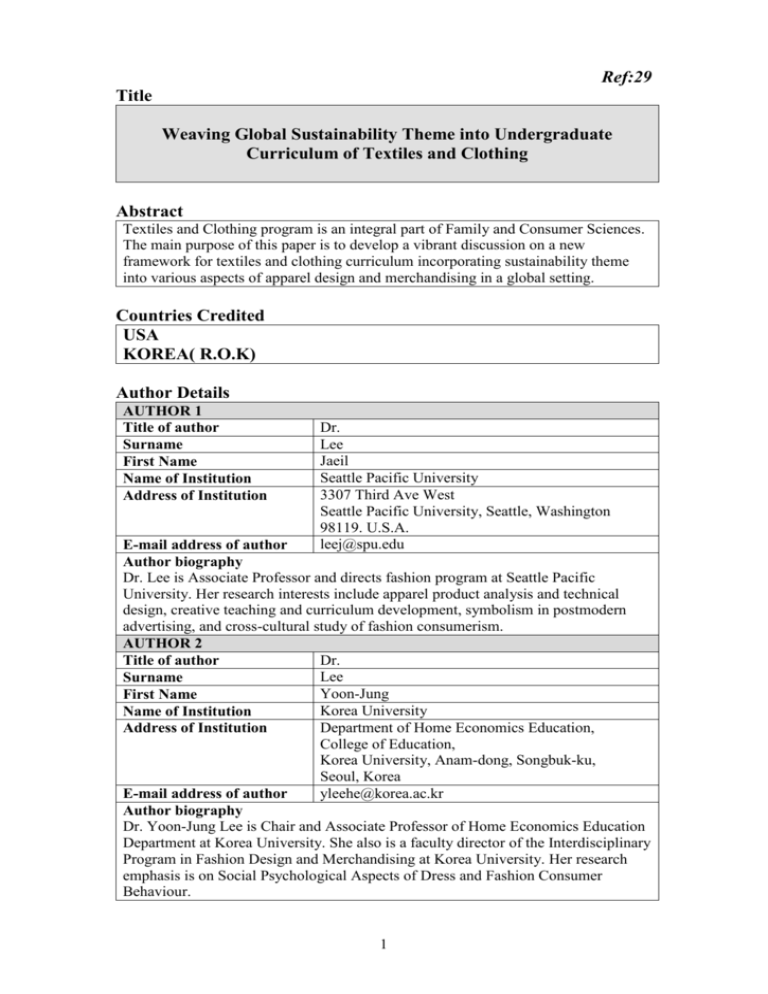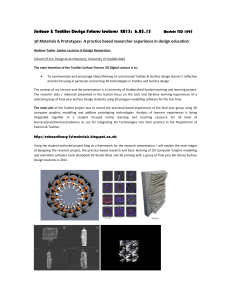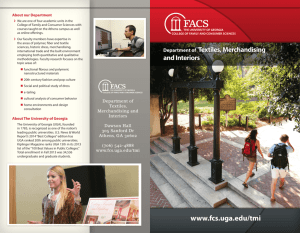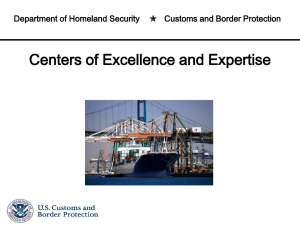paper_29
advertisement

Ref:29 Title Weaving Global Sustainability Theme into Undergraduate Curriculum of Textiles and Clothing Abstract Textiles and Clothing program is an integral part of Family and Consumer Sciences. The main purpose of this paper is to develop a vibrant discussion on a new framework for textiles and clothing curriculum incorporating sustainability theme into various aspects of apparel design and merchandising in a global setting. Countries Credited USA KOREA( R.O.K) Author Details AUTHOR 1 Title of author Surname First Name Name of Institution Address of Institution Dr. Lee Jaeil Seattle Pacific University 3307 Third Ave West Seattle Pacific University, Seattle, Washington 98119. U.S.A. leej@spu.edu E-mail address of author Author biography Dr. Lee is Associate Professor and directs fashion program at Seattle Pacific University. Her research interests include apparel product analysis and technical design, creative teaching and curriculum development, symbolism in postmodern advertising, and cross-cultural study of fashion consumerism. AUTHOR 2 Dr. Title of author Lee Surname Yoon-Jung First Name Korea University Name of Institution Department of Home Economics Education, Address of Institution College of Education, Korea University, Anam-dong, Songbuk-ku, Seoul, Korea yleehe@korea.ac.kr E-mail address of author Author biography Dr. Yoon-Jung Lee is Chair and Associate Professor of Home Economics Education Department at Korea University. She also is a faculty director of the Interdisciplinary Program in Fashion Design and Merchandising at Korea University. Her research emphasis is on Social Psychological Aspects of Dress and Fashion Consumer Behaviour. 1 Category Sustainable Development Home Economics Education Theme Environment Sustainable Consumption Type of Contribution Discussion Paper 2 Weaving Global Sustainability Theme into Undergraduate Curriculum of Textiles and Clothing Jaeil Lee and Yoon-Jung Lee The Textiles and Clothing program is an integral part of Family and Consumer Sciences (FCS), an applied field of study which deals with issues related to individuals, families and communities. The world’s production of textiles and clothing are growing, especially with the development of efficient production and consumption methods that involve uses of energy, toxic chemicals and sometimes unhealthy labor conditions. 1 The clothing and textiles program should prepare students with the knowledge of sustainable apparel design, production, merchandising, and consumption so that they can become more sensitive to the potential harms that the industry may cause to families, consumers and communities. The main purpose of this paper is to develop a vibrant discussion on a new framework for textiles and clothing curriculum incorporating sustainability theme into various aspects of apparel design, product development, and merchandising in a global setting. In order to achieve the goal, several questions are raised. 1) What are the current trends of Textiles and Clothing Curricula?; 2) How well are the sustainability issues reflected in the current U.S. undergraduate Textiles and Clothing curricula?; 3) How can we develop and implement a Textiles and Clothing curriculum that discusses sustainability issues in apparel design and merchandising in a global setting?; And lastly, 4) What are the expected outcomes of the implementation for the future? Based on the findings of the paper, a new apparel design course including objectives, learning activities, schedule, assessment tools, and other related course details, is developed as an example. Defining sustainability in textiles and clothing area Sustainability is an environmental terminology which means ‘the awareness of the short term and long term consequences of any transformation of the environment’.2 The concept of sustainability can apply to various aspects of human life in that it is an ethical and ecological proposition related to various areas of our JM Allwood, SE Laursen, CM Rodriguez, & NMP Bocken, ‘Well dressed ?’, The present and future sustainability of clothing and textiles in the United Kingdom, University of Cambridge Institute for Manufacturing, Cambridge, 2006. 2 LD Burns & NO Bryant, The business of fashion, Fairchild Publication, New York, 1997, p.415. 1 3 everyday life. Thus, the difficulty with the term ‘sustainable’ is that the term is very elusive and inclusive, and does not have any clear-cut, universally–accepted definition. In other words, the term may be interpreted in various ways. Therefore, it is recommended that the term is used more as a philosophy or a way of life than a label.3 An apparel product may be considered sustainable if it can be created without generating negative environmental effects, without causing wastes to accumulate as pollution, and without compromising the wellbeing of workers or communities. 4 Sustainable apparel design and merchandising start with the design creation, production process, use, and discard of apparel products. 5 In case of apparel production, more and more textiles and clothing products result from global production as their components and manufacturing operations originate from around the world. 6 Thus, the sustainability issue in clothing and textiles production, marketing process, consumption and discarding process needs to be taken into consideration within a global context, which focuses on the issues of fair trade and labour condition. Sustainability in undergraduate curriculum of Textiles and Clothing Since it is imperative that future professionals in the industry are equipped with the sensitivity to sustainability issues, a serious review of the current Textiles and Clothing Curriculum is needed. We examined the current curriculum of Textiles and Clothing in 4 year universities in the U. S., for the purpose of obtaining insights for a new curriculum framework development. Ten representative universities in the U. S. which have undergraduate Textiles and Clothing programs are selected from the directory of International Textiles and Apparel Association issued in the year of 2006. The selection criterion was the program size as measured by the total number of faculty members. The 10 schools selected are listed below in Table 1. For the chosen schools, we have visited the departmental website to obtain the most current curriculum to review. Course requirements and course descriptions for each school were carefully reviewed and compared to each other. 3 Sustainable dictionary, sustainable, retrieved 1 October, 2007,< www.sustainabletable.org/ intro/dictionary>. 4 ibid. Burns & Bryant, op.cit. 6 K Dickerson, Textiles and Apparel in the global economy, 3rd edn, Prentice Hall, New Jersey, 1999. 5 4 Table 1. List of 10 representative schools 10 representative schools 1. Fashion Institute of Technology 2. Auburn University 3. Colorado State University 4. University of Delaware 5. Florida State University 6. Iowa State University 7. University of Minnesota 8. University of North Carolina 9. Oklahoma State University 10. Ohio State University What are the current trends of Textiles and Clothing Curricula? All ten schools reviewed have 2 main specializations of Textiles and Clothing: Fashion Merchandising and Apparel/Fashion Design. Core courses which cover foundational knowledge of the discipline are required for both specializations: Introduction of Fashion Industry, Textiles, History of Costume and Appearance and Culture, etc. In addition to these core courses commonly required for all students, separate lists of courses were designated for each specialization. For example, courses like Retail Merchandising, Merchandising Product and Market, Retail Math, etc were required for Fashion Merchandising specialization and Fashion Illustration and CAD Design, Flat Pattern, etc for Apparel Design specialization. How well are the sustainability issues reflected in the current U.S. undergraduate Textiles and Clothing curricula? There are no specific course titles and course descriptions reflecting the issues of sustainability in the 10 schools’ curricula reviewed. At least sustainability issues have not been reflected in the current U. S. undergraduate Textiles and Clothing curricula at the course title level. Some schools offer upper division seminar courses such as “Special Topics” or “Workshops”. These courses do not have any specific topics preset before the course is taught. The course might be the possible courses in which the content of sustainable 5 issues may be included. However, since there is no specific information available in the course description, it was impossible to check whether these courses dealt with sustainability issues or not. How can we develop and implement a Textiles and Clothing curriculum that discusses sustainability issues in apparel design and merchandising in a global setting? Currently, sustainable design is a budding trend in the fashion industry. Several companies in the industry incorporate the sustainability theme into their production and marketing. Nike, one of the previous trouble makers for their practices such as involvement with sweatshops, toxic content of their shoes, manufacturing short-life disposable shoes, has become the leading advocate of sustainability. How they approached and applied the concept of sustainability gives us insights regarding how we can apply the concept in the current Textiles and Clothing curriculum. Nike’s new line, “Considered” is a great example. Their goal is to incorporate recycled rubber, use only total component disassemble materials, reduce manufacturing wastage, and abstain from using adhesives of any kind to reduce the toxic effect on the environment and workers in their factories. They also try to source materials for production within 200 miles of factories in order to reduce fuel consumption. 7 Sustainable issues should be incorporated in each specialization, Apparel Design and Fashion Merchandising uniquely since the two are very different in its nature. Sustainability theme should be weaved into various aspects of 1) product design, 2) product development and production, 3) product merchandising, and 4) consumer’s product use and disposal. Sustainable design begins with the inspiration and design creation when there is a marriage between the concept of green design and ecofriendly material (e.g., recycle material, organic cotton with non-hazard/ toxic free production process). It is connected to green production process, hand in hand with energy efficiency as well as environment friendly manufacturing process (e.g., manufacturing by solar energy). Related to the increase of global production practices, sustainability issues are also pertained to the issues of fair trade and work condition (e.g., sweatshops and child-labour). The consumption of apparel products may also 7 Nike considered: Hope for the Sinners? , retrieved 7 March 07, <www.treehugger.com/files/2005/03/nike_considered.php>. 6 involve how consumers care for (1 hour tumble dry versus 10 minutes natural dry) and discard apparel products (recycling versus permanent disposal). Students will need to be sensitive to sustainability issues in various steps of apparel product lifecycle, from conception to disposal, and this cannot be achieved by simply talking about it during class once or twice. Only after students actually engage in sustainable practices, the concept or philosophy of sustainability will be internalized and become a part of their lifestyle. Professors or instructors in universities and colleges will need to be creative in developing various approaches to be incorporated in the Textiles and Clothing curriculum. What are the expected outcomes of the implementation for the future? Students are the future professionals of the industry. In several years, they will be in the position to direct the design, production and merchandising process in the Clothing and Textiles industries. Therefore, equipping these future professionals with the increasing awareness of and sensitivity to sustainability is imperative. As mentioned above, sustainability is a philosophy or a way of life. Helping the students develop a sustainable way of life probably is more important than trying to conserve the environment. It will ultimately provide a better environment to the future generations and further enhance the well-being of individuals, families and communities who will continue to have clothing needs. 7 Example of new curricular development—Sustainable Apparel Design Course As an example, we propose an upper division Apparel Design Studio course reflecting sustainability. System Semester (15 week course) Course Name Eco-Friendly Apparel Design Course Required course for junior or senior students in the apparel design major Characteristics upper division apparel design studio course Course Format Lecture and studio course Total Credit 3 Credits Prerequisite Basic Sewing Course Fashion Illustration I Flat Pattern Design I Fashion Trend Analysis. Course Objectives 1. Understand the history and concept of sustainability 2. Forecast up-coming fashion trend 3. Apply the concept of eco design in apparel design 4. Develop sustainable design lines Learning activities Lecture 1. History of sustainability ( 1week) 2. Different aspect of sustainability (1 week) 3. Design aspect of sustainability ( 1 week) 4. Application of sustainability ( 1 week) Student Studio 1. Group work- research and theme selection( 1 weeks) 2. Group work- design selection ( 1week) 3. Product development (6 week) 4. Fashion show production ( 3 week) Assignments 1. Individual project: Green design concept paper: Include the history of green design and the current trends in the industry. 2. Group project: Current fashion trend analysis and product development plan presentation 3. Group and individual project: Based on the group project in #2 (trend analysis and product development plan), produce a collection of green products: - Using eco-friendly material and/or reusable or recycled fabric/clothing, reconstruct garments that are trendy in styles - Try to minimize waste as much as possible 8 - Try to implement an eco-friendly process wherever possible Assessment Participation 20% T Test 20% I Individual green design concept paper 10% G Group work 20% Design product development 20% Show case production 10% 9 References Allwood, J. M., Laursen, S. E., Rodriguez, C. M., & Bocken, N. M. P. Well dressed? The present and future sustainability of clothing and textiles in the United Kingdom, University of Cambridge Institute for Manufacturing, Cambridge, 2006. Burns, L. D. & Bryant, N. O. The business of fashion- Designing, manufacturing, and marketing, Fairchild Publication, New York, 1997. Dickerson, K. Textiles and Apparel in the global economy, 3rd edn, Prentice Hall, New Jersey, 1999. International Textiles and Apparel Association. ITAA Membership Directory, International Textiles and Apparel Association, Colorado, 2006. Nike considered: Hope for the Sinners? , retrieved 7 March 07, <www.treehugger.com/files/2005/03/nike_considered.php>. Sustainable dictionary, sustainable, retrieved 1 October, 2007, < www.sustainabletable.org/ intro/dictionary>. Wikipedia, Sustainable Design, retrieved 1 October, 2007. <www.en.wikipedia.org/wiki/sustainable_design>. 10





